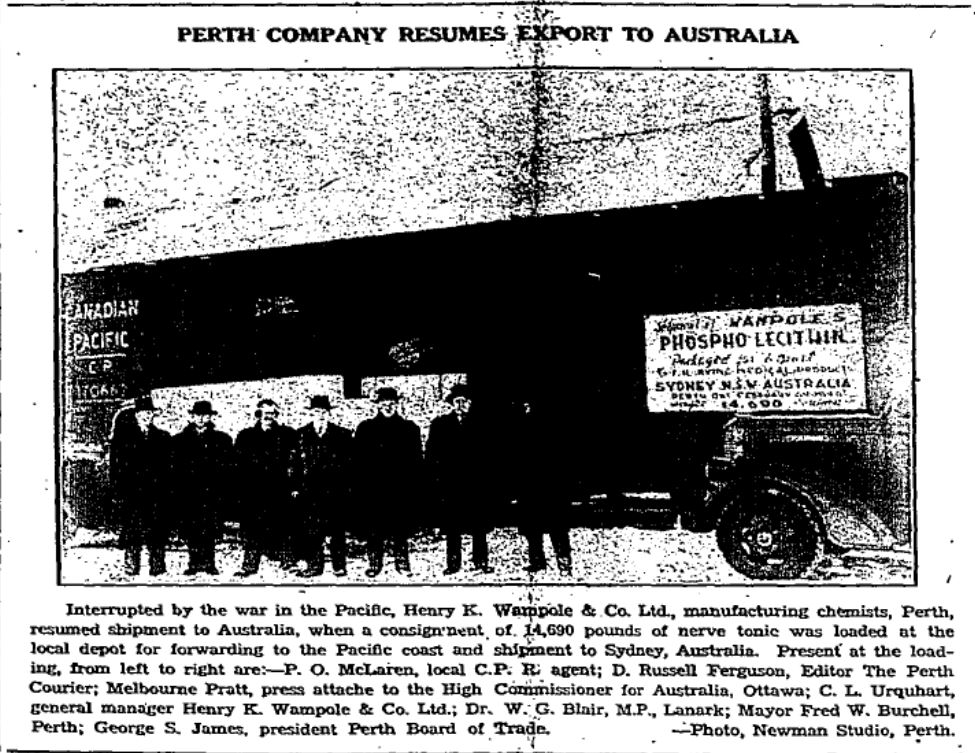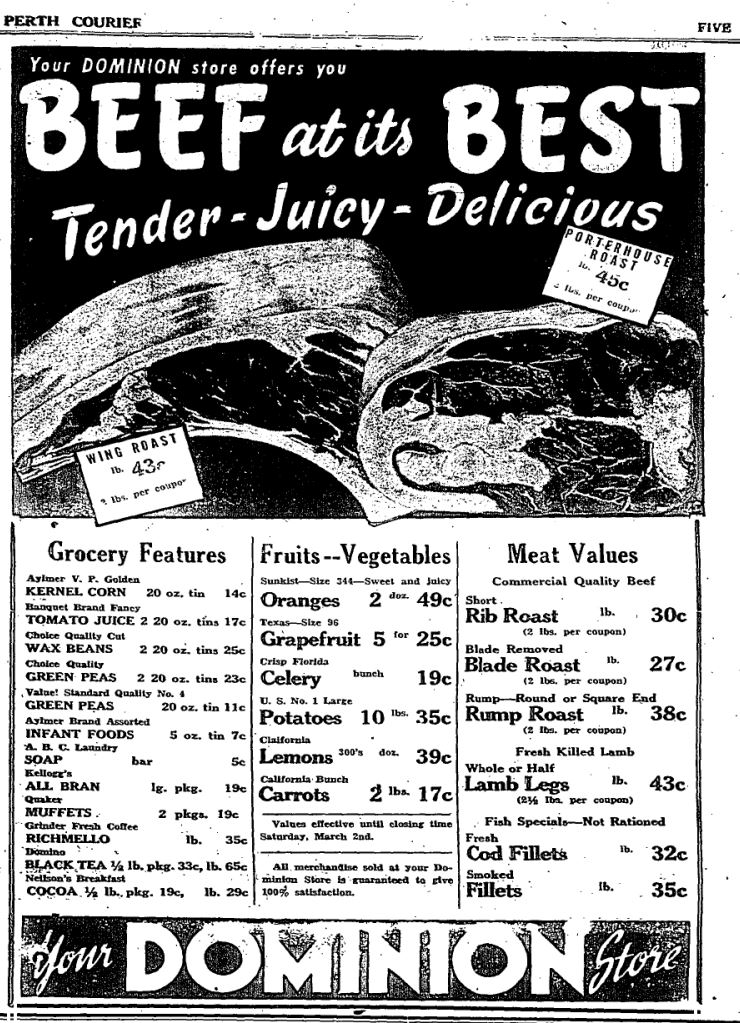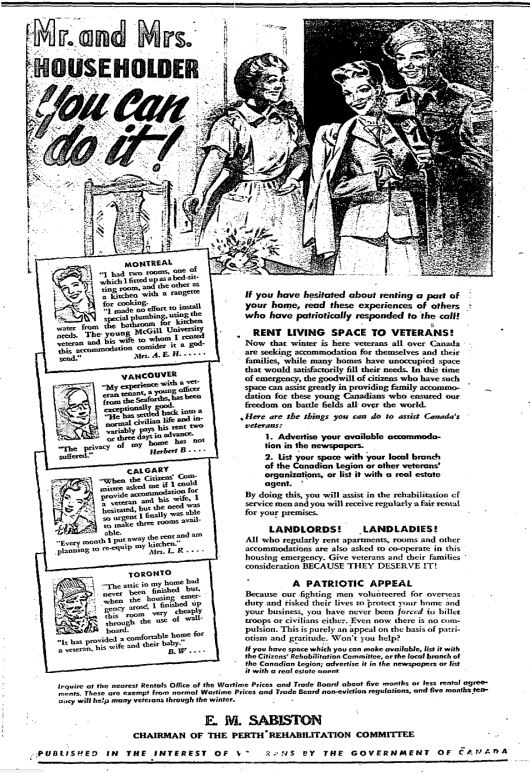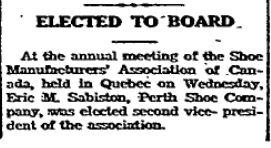The World I Entered – Part 2
‘The World I Entered’ posts are lengthy and probably not to every readers taste. Dip into them as you will. They are background for future posts and will allow me to provide links for family history down the road.
Part 1, and now Part 2, give us a glimpse of ‘the norm’ of life during and immediately following the war. In February 1946, the post-war adjustment is becoming more clearly defined. Industries that stayed viable during the war revel in the opening of markets and anticipated a retail boom once rations are lifted. Farming remains the life blood of Lanark County, but the industrial age is catch up and changes are coming quickly. Prices for farm products are low; the work day is long and physically demanding. Mechanization, hydro and other changes will occur in the next few years, but military demands for machinery during the war years have delayed the transition to mechanized equipment and new techniques.
Veterans, many of them farm boys, have had a taste of life away from the rural setting. They return to limited employment opportunities in the home community and the family farm is often, no longer an option for their future.
Long held community icons and traditions are threatened in the Canadian rush to modernize, to streamline, to become efficient. The Lanark and Renfrew Scottish Regiment, a connecting force in the community since settlement times, is threatened.
Lanark County is a place that values traditions. Older men have keep the home fires burning so that the hundred-year history of the Perth Citizen’s band would not be lost.
In January, the routine structures of the community, the council, the farm groups and the things that make local life ‘work’, were the order of the day.
Great hopes are held for the new organization – The United Nations and the glorious vision for its role in the world to come. In February we learn more about this dream and how it is interpreted by various groups.
We learn more details about the war and the experiences that the ‘returning boys’ have lived.
Into this environment come news of a skating champion, Barbara Ann Scott, with ties to the town. She was a local celebrity and her name was often mentioned in our home. So many of my younger sister’s friend were ‘Barbara’. She left her mark on the community and on Canada.
February 1946
The Articles and Headlines in the Perth Courier
Andrew Jergens Company Loads Twenty-six Tons of Products for Durban South Africa.
The shipment loaded last week is valued at over $20,000. Transit to South Africa will be made by way of New York on the Canadian Pacific Railway. Previous shipments have been sent to India and an inquiry has just been received by a Middle East country.
Wampoles Resumes Export to Australia
The following photo gave me a chuckle. I grew quickly and always was tired and lacking energy. I was give bottles of Phospho-Lecithicin when I was a child! In the days before government organized health care, tonics and other cures were tried before resorting to a trip to the doctor. In retrospect, it was environmental sensitivities and possibly childhood asthma that were my problem.

Excitement as international trade returns for the Wampole Company
Food and the Grocery Store
Although home gardens were still supplying much of a family’s food in the rural areas, and ration cards were still in use, local stores advertised a supply of basic foods. The Dominion store was favored by the family in my early years. Then the IGA offered Gold Bond stamps and that is another story!

Dominion Store Ad 28 Feb 1946 Perth, Ontario, Canada
The Focus of the Agricultural Sector
This month the messages in the agricultural community had moved from local husbandry concerns to a broader vision for the future of agriculture in the ‘new world’. People were moving from ‘survival’ mode to daring to think about a ‘new future’.
Address to Canadian Federation of Agriculture by H.H. Hannam
“The development of international commodity agreements in the marketing of major farm products is vital in the establishment of security in agriculture, and to the success of the United Nations peace program.”
“It is now clearly seen that a prosperous agriculture is impossible of attainment on purely national lines.”
“The pattern for peace is simple. It is that from now on the nations of the world must proceed as one family. They must share equitably the advantages of living in a world of plenty; but they must also share equitably the responsibilities involved, even if it means a new concept of sovereignty. Most nations have been successful in maintaining law and order within their national borders. Now they together must establish a plan for law and order within the borders of our ‘one world’ and make it work. The complete United Nations program is the start! The end is some form of world government, or as Tennyson had the vision and courage to dream of as far back as 1842, the parliament of man and the federation of the world; It could come true in our day.”
Preparation for the Spring Farming Season

Getting ready for spring – advertisement for day-old chicks and the cooperative movement
This ad introduces two components of my family’s history – the Cooperative movement and the raising of chicks, the stories to be told in future postings.
Rehabilitation Plan Implementation
The local rehabilitation committee was chaired by Eric Sabiston and this was the first of a series of appeals to local residents to help the returning veterans.

Perth Rehabilitation Committee Ad 14 Feb 1946 Perth Courier, Ontario, Canada

Erick Sabiston, 10 Jan 1946 in the Perth, Courier, Perth, Ontario, Canada
Erick Sabiston married Eleanor Pollock. His parents were Alexander Sabiston and Henrietta Carroll Moorhouse. Henrietta’s parents were Henry Moorehouse, a partner of Ralph Dodds (my great grandfather) in the woolen mill at Glen Tay, and Elizabeth Eveline Adams. Elizabeth’s parents were Captain Joshua Adams and Elizabeth “Betsy” Adams, early 19th century industrialist of Adamsville, later known as Glen Tay. During his Perth years he lived in the house that is now Known as Perth Manor During high school years there rule that you couldn’t smoke in sight of the school. Walking along ‘the wall’ was like walking the gauntlet for a shy gal. His daughter Elizabeth, was one of my high school friends.
Lanark and Renfrew Scottish Regiment
The military tradition of the county was first lauded, and then threatened.
Tribute to Lanark and Renfrew Scots
Lt-Gen. Charles Foulkes who commanded the 2nd Division in France and the 1st Canadian Corps in Italy addressed the Canadian Club describing the role of Canada soldiers in the liberation of Holland. He was introduced by Lt-Col Boyd, CO of the Lanark and Renfrew Regiment. Foulkes paid homage to the regiment and made a strong plea for tolerance for returned men during their period of adjustment.
And just a short time later, the ‘bomb shell’ –
Lanark and Renfrew Scottish Regiment
Brigadier McCarter, District Officer Commanding advised the officers of the Lanark and Renfrew Scottish Regiment that the regiment would become a light anti-aircraft regiment. This change of role from an infantry regiment to an artillery regiment was in keeping with the streamlining of the Canadian Army.
The new regiment was to establish batteries in the towns of Pembroke, Renfrew and Smiths Falls, disregarding the units of the Lanark and Renfrew Scottish Regiment presently located at Arnprior, Almonte, Carleton Place and Perth. It was felt that one of the regiments from Ottawa should be given the privilege of forming a local company of their unit in Arnprior, Almonte, Carleton Place and possibly a Kingston unit forming a company in Perth.
“One can imagine someone in district headquarters with a pencil and paper looking at the population of the City of Ottawa and the city of Kingston, having in mind the number of regiments in those cities and looking at the combined population of the Counties of Lanark and Renfrew, dividing up the area covered by the Lanark and Renfrew Scottish Regiment in the manner proposed. If such a person proceeded in such a manner did he have in mind the rural area covered by the Counties of Lanark and Renfrew when the proposed division of the territory was determined?”
“The Lanark and Renfrew Scottish Regiment, for the past hundred years has played a prominent part in the life of the counties of Lanark and Renfrew and consider the area as their own, not to be infringed upon by regiments from the cities. Many are the native sons of Lanark and Renfrew counties which have served with distinction through two wars, and intervening peace, as officers and men of this famous old regiment and if the proposed change is to be effected it is but the beginning of the passing of a fine old regiment steeped in traditions.”
“Perth has always been the military town with its military traditions definitely tied up with those of the regiment. During the regiment’s long history, Perth has been the headquarters and many of the commanding officers, natives of Perth, have served it with distinction. Every effort should be brought to bear to have Perth retain its connection with the Lanark and Renfrew Scottish, regardless of whether or not it is to be an infantry or artillery regiment.”
In an excerpt from the Smith Falls Record News, the following comment was posted:
“The Lanark and Renfrew received unjustified treatment during World War II, and it would seem that such treatment is to be continued. Every effort should be made to have the grand old Lanark and Renfrew Scottish Regiment retain its identity as an infantry unit, and not be compelled to “take the air” in the kilt.”
Another Perth tradition celebrated its survival during the war years, when the boys were away.
The Perth Citizen’s Band
At the annual dinner tributes to George S. James the President of the Citizen’s Band, the bandmaster, Mr. David Greenlaw (my elementary school music teacher) and members of the band that kept it active during the war years. Mr. James traced the 100-year history of the band and suggested that it was the only town of comparable size in the Dominion in which a band had functioned continuously for a century. The bands importance as a youth training factor cannot be overemphasised. Mr. Greenlaw and senior members have devoted much time and patience to training young boys in execution and appreciation of music.
Amid all the turmoil, there was a ray of joy. Everyone celebrated the successes of Barbara Ann Scott.
Barbara Ann Scott
Clarkson College of Technology, Potsdam NY jakes Barbara Ann Scott an honorary member of Phalanx honorary society of the college. This is the first time in the history of the organization that any person outside the official Clarkson family has received this recognition. Miss Scott is the first woman to become a member of this society that requires good scholarship and promise of future success. In a second article, she is reported as having turned down several offers to turn professional and star in Hollywood cinema productions. She wishes to maintain amateur status until she wins skating honors at the next Olympic meet.
John Mather, Clerk, Town of Perth
And in this month, I find yet another example of a family member in municipal service.

John Mather, Clerk, Town of Perth, Ontario, Canada, 1946
